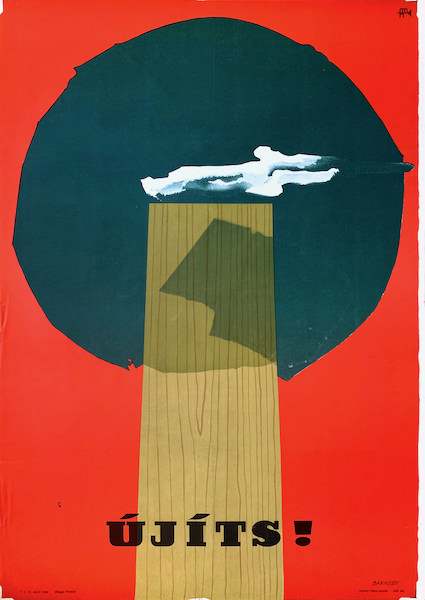
Description:
Innovate! is a 1968 vintage Hungarian work incentive propaganda poster designed by Tibor Banhegyi.
Original Hungarian vintage propaganda poster. It depicts the stylized image of a tree in front of red background. Innovation in its modern meaning is "a new idea, creative thoughts, new imaginations in form of device or method". Innovation is often also viewed as the application of better solutions that meet new requirements, unarticulated needs, or existing market needs. Such innovation takes place through the provision of more-effective products, processes, services, technologies, or business models that are made available to markets, governments and society. An innovation is something original and more effective and, as a consequence, new, that "breaks into" the market or society. Innovation is related to, but not the same as, invention, as innovation is more apt to involve the practical implementation of an invention (ie new / improved ability) to make a meaningful impact in the market or society, and not all innovations require an invention. Innovation often manifests itself via the engineering process, when the problem being solved is of a technical or scientific nature. The opposite of innovation is exnovation. Many scholars claim that there is a great bias towards the "science and technology mode" (S&T-mode or STI-mode), while the "learning by doing, using and interacting mode" (DUI-mode) is ignored and measurements and research about it rarely done. For example, an institution may be high tech with the latest equipment, but lacks crucial doing, using and interacting tasks important for innovation. A common industry view (unsupported by empirical evidence) is that comparative cost-effectiveness research is a form of price control which reduces returns to industry, and thus limits R&D expenditure, stifles future innovation and compromises new products access to markets. Some academics claim cost-effectiveness research is a valuable value-based measure of innovation which accords "truly significant" therapeutic advances (ie providing "health gain") higher prices than free market mechanisms. Such value-based pricing has been viewed as a means of indicating to industry the type of innovation that should be rewarded from the public purse. While a novel device is often described as an innovation, in economics, management science, and other fields of practice and analysis, innovation is generally considered to be the result of a process that brings together various novel ideas in such a way that they affect society. In industrial economics, innovations are created and found empirically from services to meet growing consumer demand.











